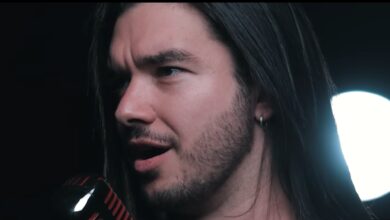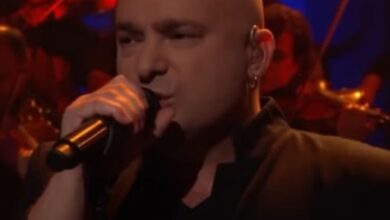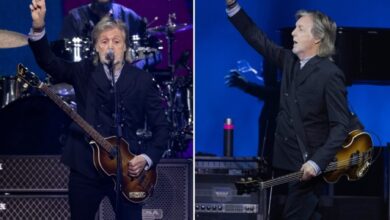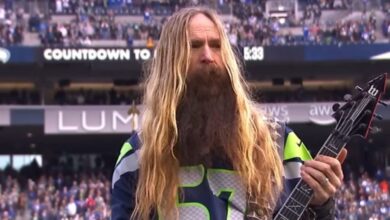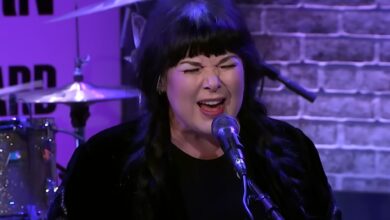Limp Bizkit Fired Up the Crowd with a Wild “Break Stuff” in Santa Clara 2025
“Break Stuff” arrived at the exact moment nu metal’s popularity was exploding. Issued as the fourth single from Significant Other on May 2, 2000, its scathing attitude and stone-simple riff caught the tail end of the late-’90s angst wave. While earlier singles “Nookie” and “Re-Arranged” flirted with melody, “Break Stuff” planted Limp Bizkit’s flag squarely in hostile territory, inviting every frustrated listener to join in a three-minute tantrum that spoke to locker-room fights, suburban boredom, and mall-rat restlessness.
The track took shape during marathon sessions at NRG Studios in Los Angeles, where producer Terry Date encouraged the band to lean into raw minimalism. Wes Borland layered chunky, palm-muted guitar lines over Sam Rivers’ throbbing bass, crafting a groove so primal it bordered on hypnotic. Meanwhile, DJ Lethal sprinkled faint record scratches between beats, and John Otto locked down a muscular drum pattern that felt like someone pounding on a steel door. Fred Durst’s lyrics were equally blunt—short, sharp declarations of rage delivered in the half-spoken, half-shouted cadence that became his trademark.
What elevated the cut beyond typical nu metal hostility was its sheer economy. Clocking in under three minutes, it wastes zero time on pretense. There’s no guitar solo, no melodic bridge, no glossy production tricks—just a verse, a chorus, a breakdown, and a closing stomp that dares crowds not to erupt. That bare-bones approach turned the song into a universal pressure valve: easy to learn, impossible to ignore, and perfectly designed for mosh-pit chaos.
By early 2000, American youth culture was simmering with pent-up energy. The dot-com boom made prosperity feel omnipresent, yet many teens felt left out, wedged between Y2K paranoia and post-Columbine anxiety. MTV’s Total Request Live mirrored that tension, bouncing from teen-pop sweetness to rap-rock aggression within the same hour. “Break Stuff” slipped into that cultural fault line as the unofficial soundtrack to after-school outbursts and basement wrestling matches, uniting skaters, gamers, and metalheads under one profane chorus.
The accompanying music video, directed by Durst himself, doubled down on the song’s rebel spirit. Filmed inside a grimy warehouse, it featured cameo appearances from Eminem, Dr. Dre, Snoop Dogg, Jonathan Davis, Pauly Shore, Riley Hawk, and even young Hailie Jade. Everyone mugged for the camera amid skate ramps, busted furniture, and dangling fluorescent lights. The result felt like a nu-metal family reunion—loud, chaotic, and gleefully subversive.
Rumor later swirled that Em and Dre regretted their cameos, partly because the video accumulated hundreds of millions of YouTube views and kept resurfacing in meme culture. Still, the clip’s cameo-stuffed exuberance cemented it as a time capsule of turn-of-the-century pop rebellion. Each guest’s split-second appearance now reads like a yearbook snapshot of 2000’s music elite, forever immortalized in baggy jeans and oversized hoodies.
Onstage, “Break Stuff” quickly became Limp Bizkit’s most combustible weapon. The song debuted in all its fury during the Family Values Tour, but Woodstock ’99 turned it into urban legend. As Durst surfed over the sea of fans on a plywood board, the crowd devolved into destructive euphoria—tearing down scaffolding, ripping plywood panels, and later setting fires. Critics pinned much of the blame on Limp Bizkit, arguing that the lyrics stoked an already volatile atmosphere.
Documentaries and think-pieces have since argued that inadequate security, soaring temperatures, and organizer negligence played larger roles in the disaster. Yet “Break Stuff” still shoulders symbolic responsibility for the riots—proof of how powerful a three-minute song can be when amplified by a restless audience and poor crowd control. Fred Durst later insisted he was merely encouraging fans to “let it out,” not encouraging property damage, but the narrative stuck.
Despite, or perhaps because of, that notoriety, the track remains a live staple. Concertgoers instinctively anticipate its chugging intro, forming swirling pits before the first lyric drops. Durst often pauses mid-song, demanding that the crowd split down the center before the final breakdown—a cue for the infamous “wall of death” collision that leaves security guards sweating and adrenaline junkies euphoric.
Beyond concerts, “Break Stuff” wormed its way into everything from WWE pay-per-view promos to skate-video soundtracks. Its blunt aggression perfectly matches slow-motion backflips, hockey fights, and UFC highlight reels. Even mainstream commercials have flirted with its riff—though usually in sanitized instrumental form—proving its crossover appeal.
Parodies soon followed. Lounge singer Richard Cheese transformed the tune into a Vegas croon, complete with cocktail-bar piano. YouTubers re-imagined it as an ’80s synth-pop number, while TikTok creators mashed it with bubble-gum K-pop beats. Each tongue-in-cheek cover highlights how recognizable that four-note riff is, no matter the genre.
Today, the song enjoys a vibrant second life on social media. Short-form clips use the iconic “give me somethin’ to break” shout as a cue for quick costume changes, home-renovation reveals, and comedic rage quits in gaming streams. Its lyric-video uploads collectively rack up millions of daily streams, proving Generation Z finds the same catharsis Gen-X once did.
As 2025 marks a quarter-century since its single release, fans have begun posting anniversary tributes—rare demo snippets, concert bootlegs, and heartfelt essays about smashing up bedroom furniture to the song back in high school. Even critics who once dismissed Limp Bizkit grudgingly acknowledge that “Break Stuff,” for all its bluntness, distilled an era’s frustration better than any graduate-level thesis ever could.
Part of the track’s longevity stems from Limp Bizkit’s refusal to apologize for it. While the band has experimented with EDM remixes and ironic yacht-rock medleys, they still play “Break Stuff” every night, often as the closing encore. Durst, now sporting tinted aviators and a silver wig, treats the mike stand like a confessional booth, inviting thousands to purge their daily irritations in a single communal shout.
Ultimately, “Break Stuff” endures because it offers permission to feel angry without explanation. It compresses the messy spectrum of human frustration into a fist-pumping mantra you can scream alongside strangers. Twenty-five years on, that primal release remains oddly comforting—proof that, sometimes, all anyone really needs is two chords, a snare-drum crack, and the okay to break something (at least metaphorically).

